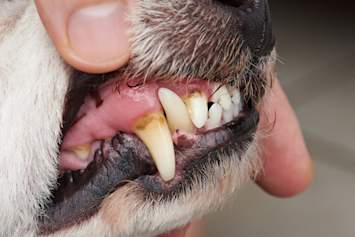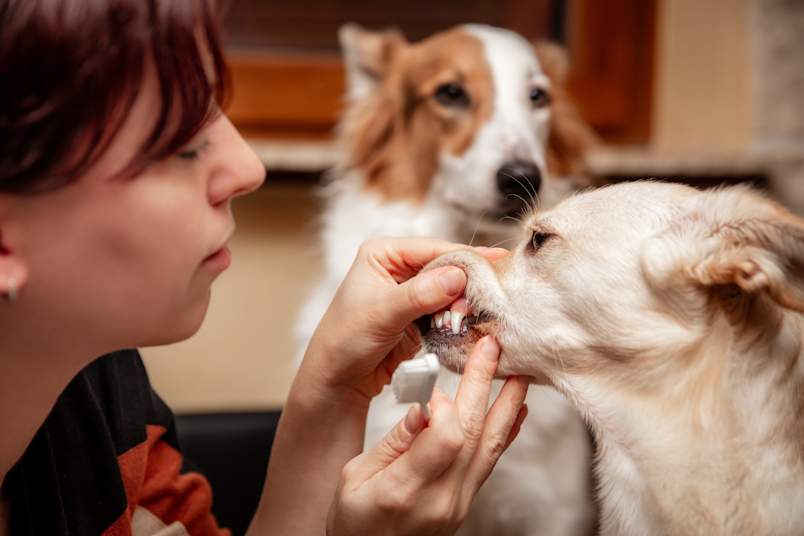
As pet parents, we want nothing more than to see our dogs happy, healthy, and flashing those adorable toothy grins. However, just like humans, our furry companions can develop cavities due to poor oral hygiene. While true cavities are relatively rare in dogs compared to humans, they can still occur and lead to serious dental issues if left untreated.
The cause of dental cavities is bacteria. Poor dental hygiene leaves behind bacteria that sets off a chain reaction in the mouth. These bacteria produce acids that eat away at teeth, weaken the enamel, and cause teeth to begin rotting. The good news is that true cavities are relatively rare in dogs because:
Canine oral bacteria are different from ours; they tend not to cause acid build up that harm teeth.
Most dogs don't consume many sugary or acidic foods that lead to bad bacteria's growth.
Canine teeth are mostly narrow and pointy, not flat and grinding, which give bacteria fewer places to take root and do damage.
Unfortunately, dogs live shorter lives, giving the bacteria less time to do damage.
Identifying Dog Tooth Cavities
Typical canine dental stains appear lighter in color than a true dog cavity, which looks dark brown or black on the tooth's surface. If they are going to happen, dog cavities typically form on upper molars or incisors. While humans might get cavities from eating too much chocolate, dogs face a much more serious risk where chocolate can be toxic to dogs and even fatal in large amounts.
Symptoms of Cavities in Dogs
If you suspect your dog may have a cavity, look out for these common symptoms: bad breath, visible holes or discoloration on the teeth, reluctance to eat or chew, especially hard foods, excessive drooling, and pawing at the mouth or face. If you notice any of these signs, schedule an appointment with your veterinarian for a proper diagnosis and treatment plan.
Stages of Cavity Progression in Dogs
Veterinarians use a scale with five stages to gauge the severity of a dog's cavity.
Stage 1 is when only the enamel is affected.
Stage 2 involves both the enamel and dentin.
Stage 3 affects the enamel, dentin, and pulp chamber.
Stage 4 is characterized by structural crown damage.
Stage 5 is when the majority of the tooth crown is lost, exposing the roots.
The treatment options for your dog's cavity will depend on the stage of progression.
When a dog does get a true cavity, veterinary dentists use many of the same techniques a human dentist would. They take dental X-rays to determine the extent of damage to the tooth, both above and below gums. In some cases, they may do a root canal to clean out and seal the tooth and root.

Preventing Cavities in Dogs
Good at home dental care and regular veterinary dental exams and cleanings can prevent or uncover canine dental disease before it gets too bad. It's important to schedule dental check-ups with your veterinarian at least once a year to catch and prevent cavities early on. Provide the opportunity for dogs to chew on safe toys or dental treats. Brushing your dog's teeth regularly with a dog-friendly toothpaste is also an excellent way to maintain their oral health.
It's important to note that you should never use human toothpastes, as they often feature ingredients harmful to pets like artificial sweeteners, including xylitol, that can be toxic. Use only dog-friendly toothpaste instead. Ask your veterinarian if you have any questions.
Protecting Your Dog's Dental Health with Pet Insurance
Investing in pet insurance that covers accidents, illnesses, and preventative care can be a lifesaver when it comes to managing the costs associated with your dog's dental health. When choosing protection for vet bills, it's essential to select a plan that includes dental coverage to ensure your furry friend receives the necessary care without putting a strain on your finances.
Some pet insurance providers offer comprehensive plans that cover dental accidents and illnesses, such as tooth extractions, and gingivitis treatment. They may also provide optional, non insurance wellness plans that can be added to your policy to help budget for the cost of routine dental care, like annual cleanings and exams.
By choosing a pet insurance plan with dental coverage, you can have peace of mind knowing that you're prepared for unexpected dental issues that may arise. You'll also want to provide your dog with the best possible care, including regular check-ups and cleanings, which can prevent more serious and costly dental problems down the line.
Safeguarding Your Dog's Smile
Remember, a healthy mouth goes beyond a sparkling smile. Good dental hygiene contributes to your dog's overall well-being, allowing them to eat comfortably, play freely, and live a pain-free life. With the information and tips provided here, you're well-equipped to safeguard your pup's dental health. From regular vet checkups and cleanings to incorporating dental chews and brushing at home, these simple steps can make a world of difference.
A dog's goofy grin has the power to melt away stress, brighten a gloomy day, and fill our hearts with joy. Every tooth in your dog's mouth holds a story – a playful game of fetch, a delicious treat enjoyed, a slobbery kiss of pure love. By taking care of their dental health, you're ensuring a lifetime of happy memories, big and small. With these simple tips, you can help your furry friend keep their smile bright and their chompers strong, for all the adventures yet to come.